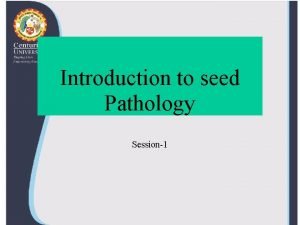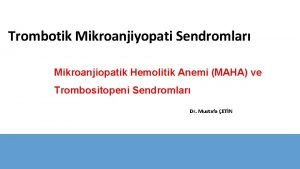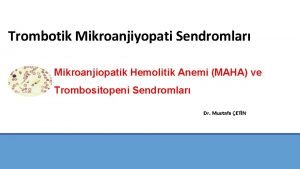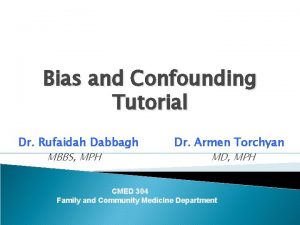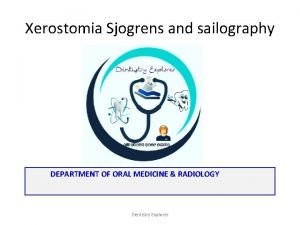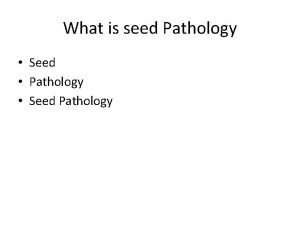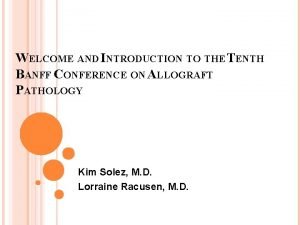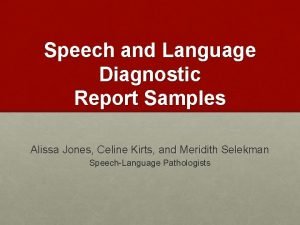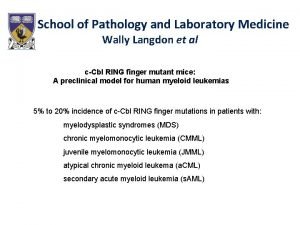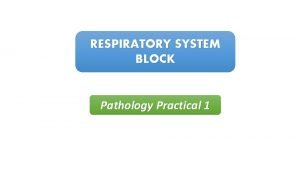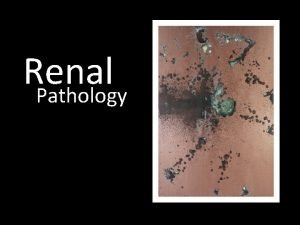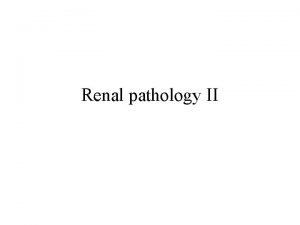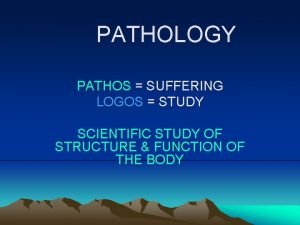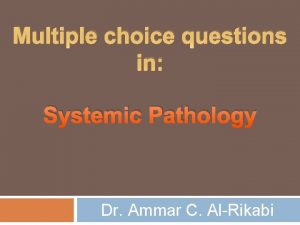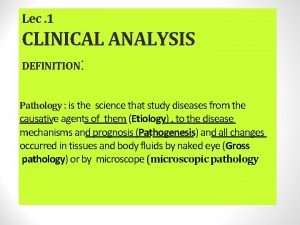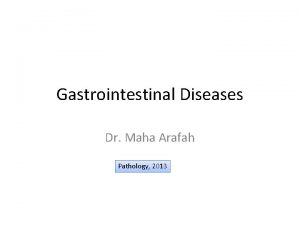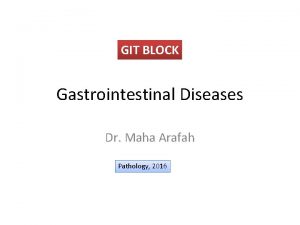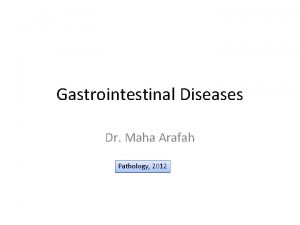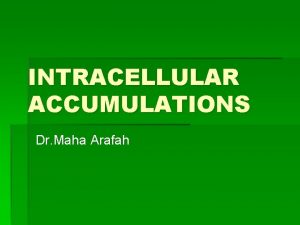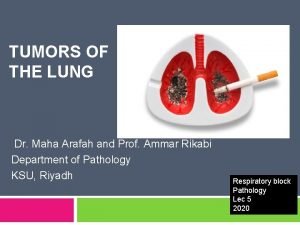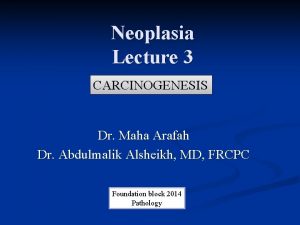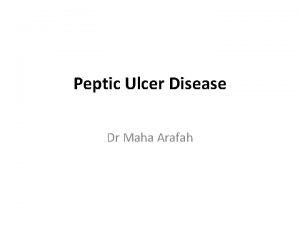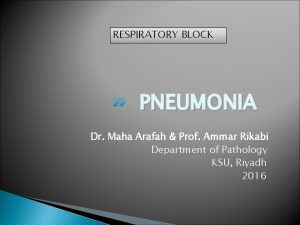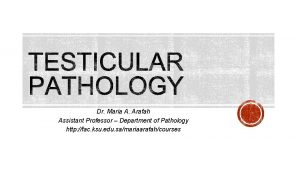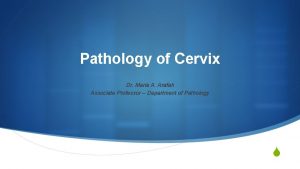INTRODUCTION TO PATHOLOGY Dr Maha Arafah Assistant Professor















































- Slides: 47

INTRODUCTION TO PATHOLOGY Dr. Maha Arafah Assistant Professor Department of Pathology King Khalid University Hospital and King Saud University Email: marafah@ksu. edu. sa marafah @hotmail. com Lecture Date: 14 -9 -2011

Objectives: � Students at the end of the lecture will be able to: Understands the definition of pathology. Understands the concept of disease. Become familiar with the important terminology which are used to study a disease like: epidemiology, aetiology, pathogenesis and prognosis. Understands the meaning of idiopathic or essential disease. � Be familiar with the classification of diseases which is usually based on their pathogenesis. � Have an organized framework for thinking and acquiring information about diseases. � � �

Introduction to Pathology � Learning Resources: � a) Textbooks: �Robbins. Basic Pathology. ○ (Required Text Book) �Robbins. Pathologic basis of disease. ○ (Reference) � b) laboratory �Glass slides �Museum for gross examination of organs

Introduction to Pathology � You can access the college website for extra reference and materials at: http: //www. ksu. edu. sa/sites/Colleges/Medicine/Pathology/ � You can visit my faculty member’s website as follow: http: //faculty. ksu. edu. sa/drarafah

Introduction to Pathology � Other websites that can be visited include: http: //www. pathweb. ubc. edu http: //www. path. uiowa. edu/virtualslidebo http: //library. med. utah. edu/Web. Path/webpath. html http: //www. mic. ki. se/PATHOL. html http: //www. cap. medical. org/ http: //www. objectivepathology. ca/Public. Client. Images/ http: //www. palms. med. usyd. edu. au/pathology_museum/ http: //pathorama. ch/ http: //www. pathmax. com http: //www. oncolink. upenn. edu/ http: //www. afip. org/ http: //www. cttr. org/

Evaluation � Small group attendance � PBL case exam � Midterm MCQ � Final MCQ � OSPE Total 5 10 25 30 30 100

� Case scenario � Slide � Questions � 1 � 2 � 3

INTRODUCTION TO PATHOLOGY Objectives: � � Understands the definition of pathology. Understands the concept of disease. Become familiar with the important terminology which is used to study a disease like: epidemiology, aetiology, pathogenesis and prognosis. � Be familiar with the classification of diseases which is usually based on their pathogenesis. � Understands the meaning of idiopathic or essential disease. � Have an organized framework for thinking and acquiring information about diseases. �

PATHOLOGY � Pathology is the study of disease processes. �It provides the link between basic biological sciences and the practice of medicine. �It discusses the disease particularly in terms of etiology (what causes the disease), and pathogenesis (mechanisms that result in the signs and symptoms of the disease), as well as classification and prevention.

Health, illness and disease � There is a wide range of normality and the human body can readily adapt to changes in the environment �(e. g. by an increase in hemoglobin at an altitude where oxygen levels are low). � Disease or ill health occurs when these adaptations are defeated.

PATHOLOGY � Disease is defined as a physiological or psychological dysfunction. �It can be caused by an obvious structural abnormality such as a broken bone or a tumour or may be less well defined, as in the case of anorexia nervosa.

A lesion is any abnormal tissue found on or in an organism, usually damaged by disease or trauma. � Lesion is derived from the Latin word laesio which means injury. �

INTRODUCTION TO PATHOLOGY Objectives: � � � Understands the definition of pathology. Understands the concept of disease. Become familiar with the important terminology which is used to study a disease like: epidemiology, aetiology, pathogenesis, clinical manifestation and prognosis. Be familiar with the classification of diseases which is usually based on their pathogenesis. Have an organized framework for thinking and acquiring information about diseases.

Epidemiology provides a broad context for understanding pathology. � Both (pathology and epidemiology) provide a useful framework for classifying and understanding mechanisms of disease. � Epidemiology include sex and age distribution, incidence and prevalence of a particular disease in addition to geographics distribution. �

Epidemiology � Incidence: is a measure of the risk of developing some new condition within a specified period of time. � Prevalence : means the number of cases in a population at any one time

Epidemiology

Epidemiology

Factors which affect the incidence and prevalence of disease include: � Time: how the disease has varied over the course of time. � Place: how the disease varies geographically. � Person: what are the personal characteristics of those who suffer from the disease and how they differ from those who do not suffer from the disease, e. g. in age, sex, occupation, race, social class, behavior.

Why may the incidence of a disease change through time? � preventative measures, such as immunization programmes, or screening tests may reflect these changes

Why may the incidence of a disease change through time? � There are many well documented associations between diseases and occupation: �Ship builders and insulation workers: asbestosis; mesothelioma (malignant tumour of the lung pleura) �Rubber and dye workers: bladder cancer �Hardwood manufacturing: nasal cancer as a result of inhalation of wood dust.

Why is epidemiology important? � Providing clues for the cause � Identifying risk factors. � Planning disease prevention. � Providing adequate health care facilities. � Setting up population screening programmes. � Evaluating health care interventions.

Etiology (causes of disease) � Diseases result from the interaction between individuals and their environment. � Some diseases are the inevitable result of environmental factors (e. g. being run over by a bus) � whereas others result from an environmental or behavioural factor acting in conjunction with a genetic predisposition, (e. g. smokers with a strong family history of heart disease. )

Etiology Ø Examples of etiology: biological agents – bacteria, virus. Ø Physical forces – trauma, burn, radiation. Ø Chemical agents – poison, alcohol, nutritional disturbances Ø Genetic: Down's syndrome (extra chromosome 21). Ø - Etiologies can be specific or non-specific - Most diseases are multi-factorial (e. g. cancer, diabetes)

Etiology � Idiopathic disease: unknown cause of a disease. � Other words meaning the same: cryptogenic, essential and spontaneous.

Pathogenesis � The development of a disease. The origin of a disease and the chain of events leading to that disease.

Clinical Manifestation �A symptom is a feeling which is noticed by a patient, indicating the presence of disease or abnormality. �A sign is a manifestation that is noted by an observer.

Clinical course The clinical course describes the evolution of a disease � The disease could be acute or chronic. � Prognosis is a medical term denoting the doctor's prediction of how a patient's disease will progress, and whethere is a chance of recovery. �

Prognosis: � natural history of disease, disease outcome. � Diseases are often discussed in terms of their morbidity (degree of "illness" involved) and mortality. ○ 5 - and 10 -year survival rates are often used as an expression of the disease outcomes. ○ E. g. , in some types of lung cancer, the 5 -year survival rate is 0%.

INTRODUCTION TO PATHOLOGY Objectives: � � � Understands the definition of pathology. Understands the concept of disease. Become familiar with the important terminology which is used to study a disease like: epidemiology, aetiology, pathogenesis and prognosis. Be familiar with the classification of diseases which is usually based on their pathogenesis. Have an organized framework for thinking and acquiring information about diseases.

Classification of Diseases � Congenital diseases are present at birth even though they may not be recognized or recognizable at that time. � Acquired diseases only occur after birth.

Type Congenital Basis Genetic Non-genetic Acquired Inflammatory Vascular Growth disorder Degenerative Drug induced Infective Metabolic Examples Reduction or absence of blood clotting factor VIII leads to haemophilia A (X chromosome linked). Cleft lip and palate. Dermatitis (eczema, inflammation of the skin), rheumatoid disease (inflammation of joints/arthritis). Atherosclerosis (deposition of lipid with thickening of blood vessels) leading to a cerebrovascular accident (stroke), myocardial infarction (heart attack). Cancer. Alzheimer's disease, Parkinson's disease. Bone marrow suppression, skin rashes, renal failure. Viral, bacterial or fungal diseases. Gout: deposition of uric acid crystals in joints and tissues. Diabetes mellitus: abnormal metabolism of carbohydrates and lack of insulin.

INTRODUCTION TO PATHOLOGY Objectives: � � � Understands the definition of pathology. Understands the concept of disease. Become familiar with the important terminology which are used to study a disease like: epidemiology, aetiology, pathogenesis and prognosis. Be familiar with the classification of diseases which is usually based on their pathogenesis. Have an organized framework for thinking and acquiring information about diseases.

The diagnostic process � Patients present with symptoms and a clinical examination elicits signs which suggest a diagnosis. �A list of possible diagnoses is constructed, known as the differential diagnosis.

The diagnostic process � The clinician then works through a series of questions: �Which organ system is most likely to be affected? �Which category of disease do the signs and symptoms most likely suggest, e. g. inflammation, malignancy or poisoning? �Do other factors such as race, age, sex, behavioural patterns or occupation of the patient provide clues to the diagnosis?

Diagnosis: � the act of identifying a disease in an individual patient and is based on clinical history, physical examination and investigation.

� Diagnosis involves clinical skills and laboratory tests: �Specialist pathological techniques can aid in diagnosis.

The role of the Pathologist � Pathology includes a large number of sub-specialities. �For example, haematologists are concerned with disorders of the blood, �immunologists are concerned with disorders of the body's immune system.

Diagnostic Pathology � Blood - blood cells - plasma - serum � Excretion and secretions - urine and faeces - sputum

Diagnostic Pathology � Effusions and exudates - protein levels - cytological examination - microbiology and culture

Diagnostic Pathology � Biopsies - needle biopsy - endoscopic biopsy - incisional biopsy � Organ resection � Frozen Section � Cytology - exfoliate cytology - fluid cytology - washing cell - fine needle aspiration cytology

Techniques in Pathology �Anatomic Pathology ○ Light Microscopy ○ Immunohistochemistry & immunofluorescence ○ Electron microscopy ○ Molecular pathology

Electron microscopy ○ Electron Microscopes (EM) are scientific instruments that use a beam of highly energetic electrons to examine objects on a very fine scale

Length • -meter(m), millimeter(mm) =10 -3 m, micrometer(µm) =10 -6 m • -nanometer(nm) = 10 -9 m, picometer(pm) = 10 -12 m. • -Angstrom = 10 -10 m Sizes of living cells • -atom - 0. 1 nm • -molecules - 0. 5 -10 nm • -viruses - 30 -80 nm • -bacteria - 2 µm • -animal and plant cells- 10 -30 µm

Autopsy The examination of the body after death. � The main purpose of the autopsy is : � �to determine the cause of death. �confirm a clinical diagnosis made in life. �identifying diseases or conditions which were not apparent in life. � Discussions between clinicians and pathologists about autopsy findings often lead to new insights into the causes and outcomes of disease. �Autopsies provide useful material for teaching.

Summary � Pathology is the study of changes which occur in cells and tissues as a result of inborn genetic, extraneous environmental or behavioural damage. � Pathology constitutes a logical and scientific basis of medicine.

TAKE HOME MESSAGES Pathology is an important discipline which help in the understanding and diagnosis of diseases. � A disease is defined as a physiological or psychological dysfunction. � Study of disease requires an understanding of epidemiology, aetiology and pathogenesis of the illness. � Classification of diseases is usually based on their pathogenesis. �

Thank You
 Attahiyat lillahi wa salawatu
Attahiyat lillahi wa salawatu Hikmah wukuf di arafah
Hikmah wukuf di arafah Ziarat arafah
Ziarat arafah Promotion from associate professor to professor
Promotion from associate professor to professor Cuhk assistant professor salary
Cuhk assistant professor salary Seed pathology notes
Seed pathology notes Mikroanjiopatik hemolitik anemi
Mikroanjiopatik hemolitik anemi Mikroanjiopatik hemolitik anemi nedenleri
Mikroanjiopatik hemolitik anemi nedenleri Maha khachab
Maha khachab Walaupun allah maha kuasa tetapi dia suci dari
Walaupun allah maha kuasa tetapi dia suci dari Ravana kingdom map
Ravana kingdom map Beriman dan bertaqwa kepada tuhan yang maha esa
Beriman dan bertaqwa kepada tuhan yang maha esa Dalil asmaul husna al matin
Dalil asmaul husna al matin District 6 maha
District 6 maha Al bashir artinya allah maha
Al bashir artinya allah maha Maha shouman
Maha shouman Allah maha esa
Allah maha esa Katakanlah dia allah yang maha
Katakanlah dia allah yang maha Voltērs
Voltērs Ttp diagnostic criteria
Ttp diagnostic criteria Maha el keshawi
Maha el keshawi Maha ka matlab
Maha ka matlab Dr maha dabbagh
Dr maha dabbagh Allah maha pembimbing
Allah maha pembimbing Allah maha kudus
Allah maha kudus Allah maha tahu
Allah maha tahu Surah allail
Surah allail Ranga ramanuja
Ranga ramanuja Maha shivani
Maha shivani Arti iman dalam bahasa arab
Arti iman dalam bahasa arab Negara berdasarkan ketuhanan yang maha esa
Negara berdasarkan ketuhanan yang maha esa Maha teliti adalah arti dari asmaul husna
Maha teliti adalah arti dari asmaul husna Dengan nama allah yang maha pemurah
Dengan nama allah yang maha pemurah Snow storm appearance in sialography
Snow storm appearance in sialography Define seed pathology
Define seed pathology Banff pathology course
Banff pathology course Job market for pathologists
Job market for pathologists Pathology outline
Pathology outline Sample diagnostic report for speech-language pathology
Sample diagnostic report for speech-language pathology Rph pathology
Rph pathology Pneumonia
Pneumonia Pathology outline
Pathology outline Grawitz tumor
Grawitz tumor Pathos pathology
Pathos pathology Systemic pathology exam questions
Systemic pathology exam questions Virtual pathology leeds
Virtual pathology leeds Clinical pathology definition
Clinical pathology definition Pathology branches
Pathology branches





